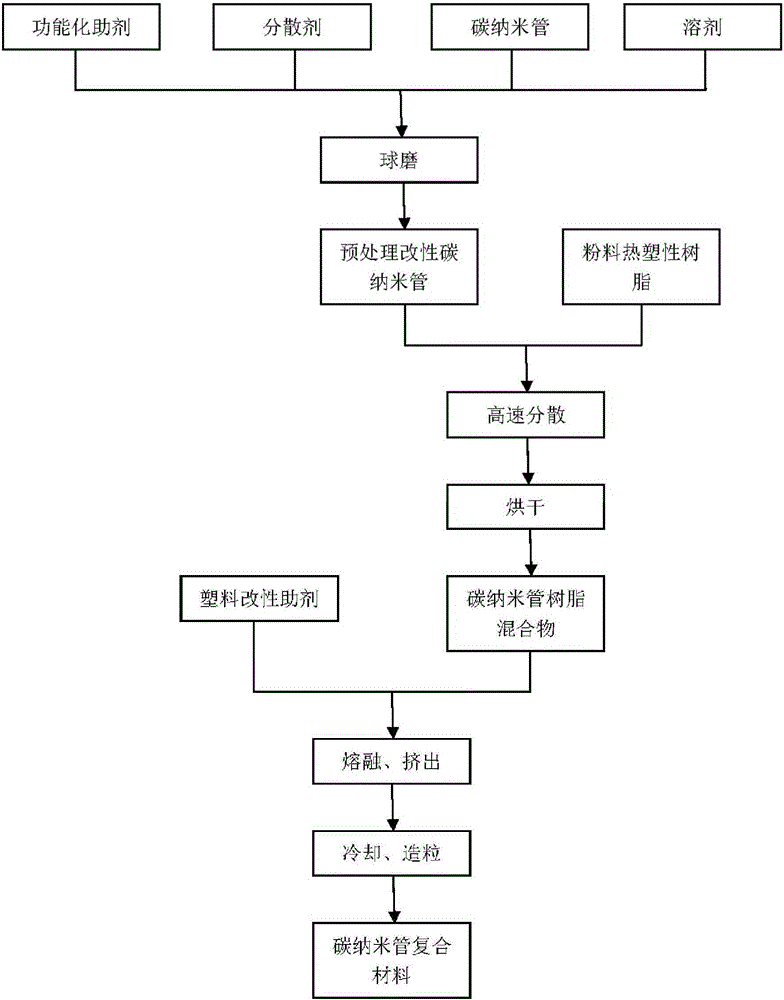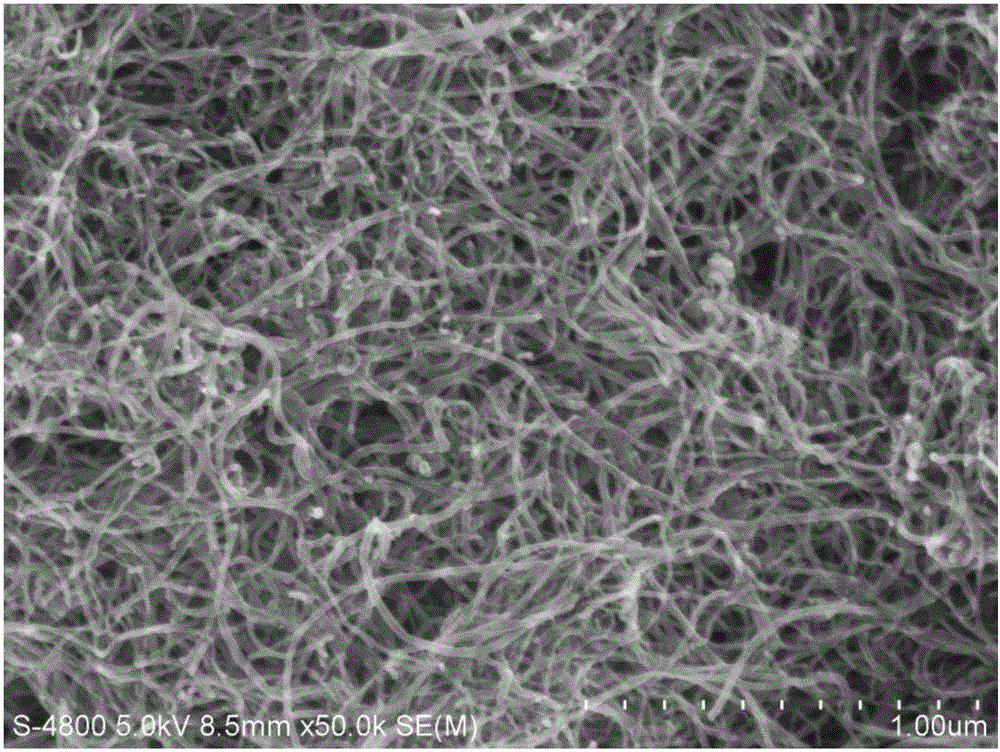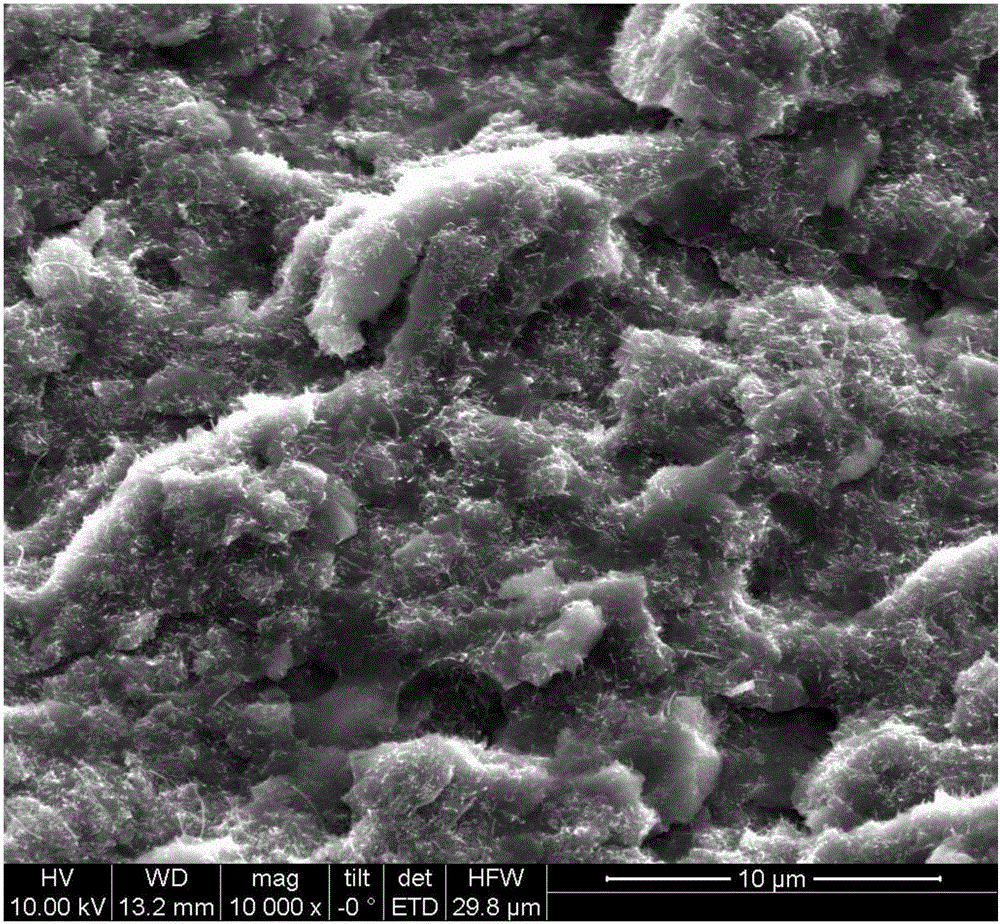Carbon nanotube modified thermoplastic resin and preparation method thereof
A carbon nanotube modification, thermoplastic resin technology, applied in the field of nanocomposite materials, can solve the problems of high equipment requirements, inability to realize industrial production, environmental pollution, etc., achieve large effective contact area, realize high volume filling, and simplify the process. The effect of the process
- Summary
- Abstract
- Description
- Claims
- Application Information
AI Technical Summary
Problems solved by technology
Method used
Image
Examples
preparation example Construction
[0030] In some preferred embodiments, see figure 1 As shown, the preparation method may include the following steps:
[0031] (1) Carrying out ball milling treatment to the mixture mainly composed of carbon nanotubes, functional additives, dispersants and solvents to obtain pretreated modified carbon nanotubes;
[0032] (2) Using a high-speed dispersion process to fully stir and mix the pretreated modified carbon nanotubes and thermoplastic resin powder to obtain a stable and dispersed carbon nanotube / resin mixture;
[0033] (3) After the carbon nanotube / resin mixture is dried, plastic modification additives are added, melted and extruded by a twin-screw machine, cooled and granulated, so as to obtain the carbon nanotube modified thermoplastic composite material.
[0034] More preferably, the mixed material comprises the following components calculated by weight percentage: 1.0% to 20% of carbon nanotubes, 20% to 30% of functional auxiliary agents, 0.01% to 1% of dispersants,...
Embodiment 1
[0052] Embodiment 1 The preparation method of the carbon nanotube modified thermoplastic resin specifically comprises the following steps:
[0053] 1) 400g of hydrogen peroxide solution, 100g of Nanocyl 7000 carbon nanotubes (provided by Belgian Nanocyl company), and 1000g of absolute ethanol are mixed (hydrogen peroxide solution accounts for 20% of the total mass of materials, and carbon nanotubes accounts for 20% of the total mass of materials 5.0% of the hydrogen peroxide solution accounts for 50% of the total mass of the material), using a star ball mill for ball milling, with a rotating speed of 300 rpm and a stirring time of 4 hours, to obtain pretreated modified carbon nanotubes, whose morphology can be found in figure 2 ;
[0054] 2) Stir the obtained pretreated modified carbon nanotubes and 1880g powder resin polyethylene terephthalate through a high-speed mixer for 2 hours to obtain a carbon nanotube resin mixture, and dry it;
[0055] 3) the carbon nanotube resin ...
Embodiment 2
[0056] Embodiment 2 The difference between this embodiment and Example 1 is that the carbon nanotube quality is 10.0g (the carbon nanotube accounts for 1.0% of the total mass of the material) in the step (1), and the carbon nanotube polyterephthalic acid The electrical conductivity of the ethylene glycol ester composite material is 1.44eS / m, and its morphology can be found in Figure 4 .
PUM
| Property | Measurement | Unit |
|---|---|---|
| diameter | aaaaa | aaaaa |
| particle size (mesh) | aaaaa | aaaaa |
Abstract
Description
Claims
Application Information
 Login to View More
Login to View More - Generate Ideas
- Intellectual Property
- Life Sciences
- Materials
- Tech Scout
- Unparalleled Data Quality
- Higher Quality Content
- 60% Fewer Hallucinations
Browse by: Latest US Patents, China's latest patents, Technical Efficacy Thesaurus, Application Domain, Technology Topic, Popular Technical Reports.
© 2025 PatSnap. All rights reserved.Legal|Privacy policy|Modern Slavery Act Transparency Statement|Sitemap|About US| Contact US: help@patsnap.com



